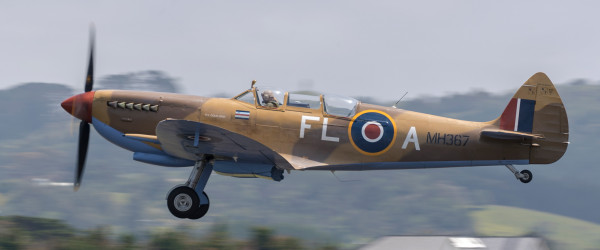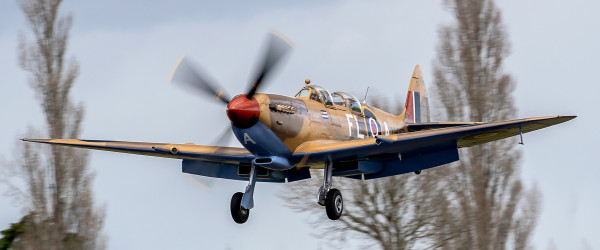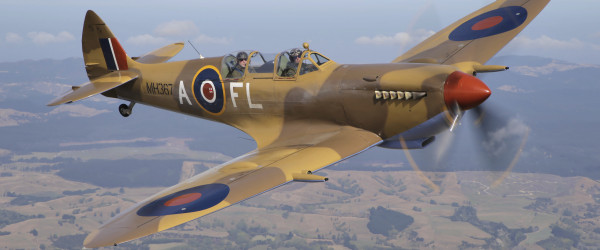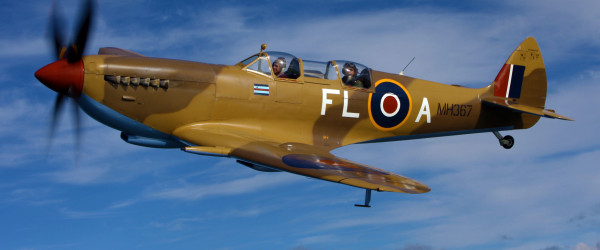Aermacchi MB-339CB
Jet Trainer
Country of Origin: Italy
Engine: Rolls Royce Viper 680-43, 4,400 lb turbojet engine
Top Speed: 898 Km/h, 558 MPH, 485 Knots




Fighter
A symbol of British defiance against Nazi Germany, the Spitfire was designed as a high performance, short-range interceptor combining superb aerodynamics with one of the best aero-engine motors of the time, the Rolls Royce Merlin. It was highly regarded by its pilots, who praised it for its flying characteristics and its ability to outturn its nemesis, the Messerschmitt Bf 109.
Since 1941, Supermarine had planned to produce a two-seat Spitfire conversion trainer to fast track pilot training but the idea was rejected by the British War Ministry. It wasn’t until early 1945 that Vickers Supermarine (as a private venture) started the construction of a prototype/demonstration aircraft in early 1945 which lead to 20 Mk IX airframes being converted to trainer spec.
MH367 served in Europe, taking part in Operations Market Garden and Varsity. In 1948 it suffered a serious landing accident and was scrapped as it was deemed surplus to supply. Its remains were discovered 40 years later and was incorporated into a Spitfire two-seat project that was underway at the time in the USA. MH367’s first post restoration flight was in November 2006 and was painted in the colours of a Mk. V Spitfire (ER570) flown by Major Robert Levine of the 4th Fighter Squadron, 52nd Fighter Group, United States Army Air Force in Tunisia 1943.
It was then sold to current owner Doug Brooker and arrived in New Zealand early May 2008 and registered as ZK-WDQ (WD-Q was ER570’s squadron code). Since then MH367 has displayed at all major NZ air shows and is a frequent flier at Ardmore Airport (mostly adventure flights). She is currently painted in the colours of EN520, an 81 Squadron RAF Spitfire that was flown by New Zealand’s highest scoring Ace, Colin Gray.
MH367 is the only two-seat dual control Spitfire in the southern hemisphere and as such allows members of the public the opportunity of flying in Supermarine’s beloved fighter for themselves.
Country of Origin: United Kingdom
Engine: Packard Merlin 266, 1710 Hp V12, 2 stage-2 speed supercharger
Length: 9.52m (31ft 4.5in)
Height: 3.58m (12ft 7.75in)
Wing Span: 11.23m (35ft 10in)
Maximum Speed: 408 mph (657 kmh or 354 knots)
Service Ceiling: 43,000ft (13,106m)
Armament: 2 × 20 mm Hispano Mk II cannons & 2 × .50 in M2 Browning machine guns
Jet Trainer
Country of Origin: Italy
Engine: Rolls Royce Viper 680-43, 4,400 lb turbojet engine
Top Speed: 898 Km/h, 558 MPH, 485 Knots
Fighter & Light Bomber
Country of Origin: United Kingdom
Engine: Fairchild Ranger 6-440-C, 200hp straight 6 piston engine
Top Speed:
Jet Trainer/Light Attack
Country of Origin: United Kingdom
Engine: Rolls-Royce Viper Mk.535 turbojet, 3,140 lbf
Top Speed:
#4 back to the skies! Congratulations to the team at @avspecs_ltd for the first flight of NZ2308 - post restoration.
📷Paul Johnston
#keepemflying #warbird #avgeek #aviation #aviator #dehavilland #mosquito #aviationphotography #pilot #flying #flight #photographer #yak#instagood #onlyinnz #nz #newzealand #aotearoa #pioneer #purenz #IfYouSeekNZ

The calm before the show.
Corsair 48 on the flight line of our recent Warbirds on Parade airshow on March 10th.
It was a stunning sunrise 🌅 👍
📸 Brian Amerasinghe
📍Ardmore Airport
#keepemflying #warbird #avgeek #aviation #aviator #aviationlovers #corsair #fg1d #voughtchance #aviationphotography #pilot #flying #flight #photographer #yak#instagood #onlyinnz #nz #newzealand #aotearoa #pioneer #purenz #IfYouSeekNZ

A great day was had by all on Sunday with hundreds turning out at the Classic Flyers NZ Aero day at Tauranga. On show was a range of static aircraft with air displays from the Yak-52 formation team, the Roaring Forties and RNZAF Black Falcons. Thank you to photographer Paul who sent these through. Looks like it was a great day!
#keepemflying #warbird #avgeek #aviation #aviator #aviationlovers #corsair #fg1d #voughtchance #harvard #northamerican #grumman #avenger #aviationphotography #pilot #flying #flight #photographer #yak#instagood #onlyinnz #nz #newzealand #aotearoa #pioneer #purenz #IfYouSeekNZ

The Roaring Forties returning from the recent Classic Flyers Aero Day 2024 with Ardmore Airport in the distance.
📸 Paul Johnston
#keepemflying #warbird #avgeek #aviation #aviator #aviationlovers #harvard #northamerican#aviationphotography #pilot #flying #flight #photographer #instagood #onlyinnz #nz #newzealand #aotearoa #pioneer #purenz #IfYouSeekNZ

CORSAIR FLYING TODAY!
Corsair NZ5648 will be flying today (Sunday 14th) with takeoff at 1100am. Come down to NZ Warbirds at Ardmore and check it out.
#keepemflying #warbird #avgeek #aviation #aviator #aviationlovers #corsair #fg1d #voughtchance #aviationphotography #pilot #flying #flight #photographer #instagood #onlyinnz #nz #newzealand #aotearoa #pioneer #purenz #ifyouseeknz

Battle of Britain Flypast✅.
It’s always privilege to commemorate such an historic day in aircraft of the same era.
Did you see us?
📷Rob New
#keepemflying #warbird #avgeek #aviation #aviator #aviationlovers #lestweforget #battleofbritain #harvard #northamerican#aviationphotography #pilot #flying #flight #photographer #instagood #onlyinnz #nz #newzealand #aotearoa #pioneer #purenz #IfYouSeekNZ

Good news for NZ warbird enthusiasts with the confirmation that the FG-1D Corsair ZK-COR took to the skies yesterday after a 6 year hiatus in storage.
Newly rated Corsair pilot Frank Parker took this picture yesterday of his view flying the historic fighter to Omaka from Hood Aerodrome.
We can’t wait to see this aircraft performing at airshows again! It’s been long over due.
#keepemflying #warbird #avgeek #aviation #aviator #aviationlovers #corsair #fg1d #vought #voughtf4ucorsair #harvard #northamerican#aviationphotography #pilot #flying #flight #photographer #instagood #onlyinnz #nz #newzealand #aotearoa #pioneer #purenz #ifyouseeknz

Another photo from Warbirds on Parade 2023. Strikemaster 72 in the hands of pilot and owner Charles Davies showing off those classic Blunty lines. 😍
It has been awesome having this machine on display at NZ Warbirds at Ardmore while it has received some maintenance from the team at Pioneer Aero.
📷 @bertscoolpics
📍Ardmore Airport
#keepemflying #warbird #avgeek #aviation #aviator #aviationlovers #bac #strikemaster #jetprovost #aerobatics#aviationphotography #pilot #flying #flight #photographer #instagood #airshow #show #onlyinnz #nz #newzealand #aotearoa ##pioneer #purenz #IfYouSeekNZ #viper

It wasn’t all about the action in the air at Warbirds in Parade 2023. A big thank you to the @militaryaviationmuseum who allowed us to show the preserved fuselage of their upcoming Douglas SBD Dauntless project which is being restored by a joint team effort involving Pioneer Aero at Ardmore and Aero Trader at Chino back in California.
📷 @sierra_tango_uniform
📍 @nz_warbirds
#keepemflying #warbird #avgeek #aviation #aviator #aviationlovers #douglas #dauntless #sbddauntless #aviationphotography #pilot #flying #flight #photographer #instagood #airshow #show #onlyinnz #nz #newzealand #aotearoa ##pioneer #purenz #ifyouseeknz

#epic “Because I was inverted” 😎
Top side of P-51D Mustang ZK-TAF flown by Graham Bethell from our big Kings Birthday show as captured by Neville Bailey.
📷 Neville Bailey
📍 Ardmore Airport
#keepemflying #warbird #avgeek #aviation #aviator #aviationlovers #northamerican #p51 #p51mustang #mustang #p51dmustang #aerobatics #aviationphotography #pilot #flying #flight #photographer #instagood #airshow #show #onlyinnz #nz #newzealand #aotearoa ##pioneer #purenz #ifyouseeknz

Mellow Yellow?
Harvard 78 flown by Jeff Hunter at last Sunday’s Warbirds on Parade.
📷@sierra_tango_uniform @stu_65
#keepemflying #warbird #avgeek #aviation #aviator #aviationlovers #aerobatics #harvard #t6 #aviationphotography #pilot #flying #flight #photographer #instagood #airshow #show #onlyinnz #nz #newzealand #aotearoa ##pioneer #purenz #IfYouSeekNZ

Achtung! Spitfire!🔥
MH367 banking tight at Warbirds on Parade 2023.
📷 @sierra_tango_uniform @stu_65
📍 Ardmore Airport
#keepemflying #warbird #avgeek #aviation #aviator #aviationlovers #supermarinespitfire #supermarine #spitfire #aerobatics #aviationphotography #pilot #flying #flight #photographer #instagood #airshow #show #onlyinnz #nz #newzealand #aotearoa ##pioneer #purenz #IfYouSeekNZ
#merlin
